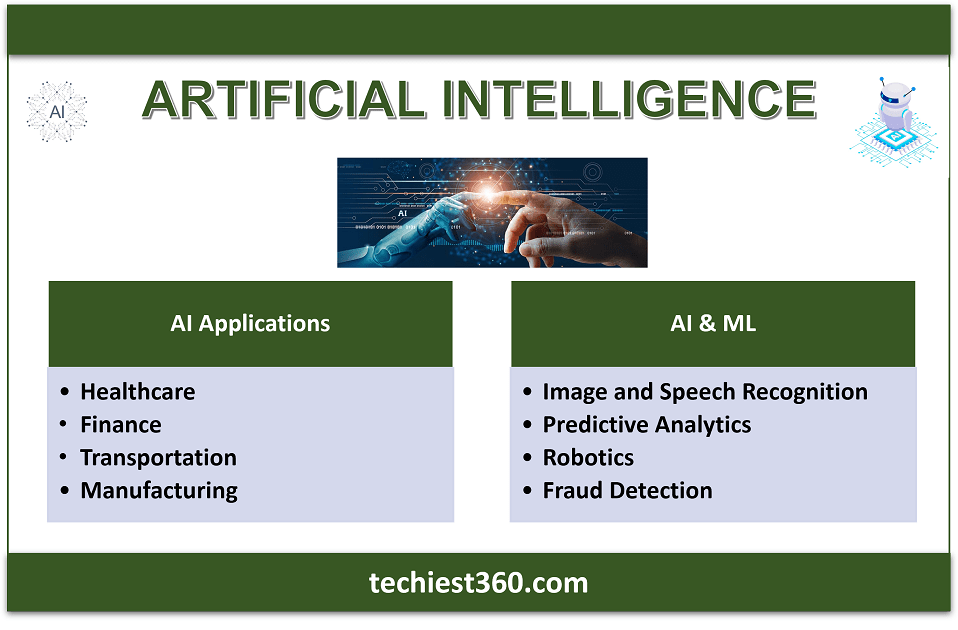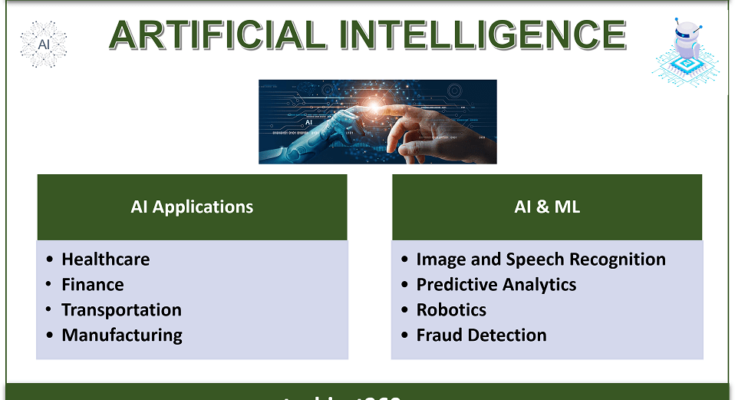Artificial intelligence (AI) studies building intelligent machines capable of carrying out tasks that usually require human intelligence, such as speech recognition, comprehending natural language, and decision-making. AI creates computer programs and algorithms to learn from data and make predictions or judgments based on that learning.

Artificial Intelligence Types
There are several types of AI, including:
Rule-based Artificial Intelligence (AI)
Rule-based AI, also known as an expert or knowledge-based system, is a type of AI that makes decisions or solves problems by following pre-defined rules. These rules are based on human experts’ knowledge and expertise in a particular field.
The rules in a rule-based AI system are expressed as if-then statements that specify a condition (the “if” part) and an action (the “then” part). For example, a medical diagnosis expert system might have a rule that states, “If the patient has a fever and a cough, the diagnosis is likely to be pneumonia.”
Rule-based AI systems typically generate output by matching input data to rules in the system’s knowledge base and then applying the appropriate direction. These systems are frequently used in domains with much explicit knowledge that can be captured as rules, such as medical diagnosis, legal reasoning, or financial analysis.
Because human experts can examine and verify the rules, rule-based AI systems are transparent and easy to understand. However, they may need to be more effective in dealing with complex or uncertain situations with no clear-cut rules.
Machine learning
Machine learning (ML) is a branch of artificial intelligence that focuses on developing algorithms and statistical models that allow computers to learn from data and make predictions or decisions without being explicitly programmed for each task. The goal of machine learning is to develop computer systems that can understand and improve without the need for human intervention.
Machine learning is classified into three types: supervised learning, unsupervised learning, and reinforcement learning. In supervised learning, the algorithm is trained on a labeled dataset that contains the correct output for each input. Image classification, speech recognition, and natural language processing are all examples of this type of learning.
Unsupervised learning involves training the algorithm on an unlabeled dataset to discover patterns or structures in the data. Clustering, anomaly detection, and dimensionality reduction are all examples of this type of learning.
The algorithm learns to make decisions based on trial-and-error feedback from the environment in reinforcement learning. This type of learning is used in applications such as gaming, robotics, and self-driving cars. Many industries and applications use machine learning, including e-commerce, finance, healthcare, and transportation. It has also aided in developing many recent advances in artificial intelligence, such as deep learning and neural networks.
Deep Learning
Deep learning is a subfield of machine learning that focuses on constructing and training artificial neural networks with multiple layers, allowing the system to learn and extract hierarchical data representations. Deep learning algorithms are particularly effective at processing complex and large datasets, such as images, speech, and natural language. They have resulted in significant breakthroughs in various applications, including image and speech recognition, natural language processing, autonomous vehicles, and many others.
Deep neural networks are composed of multiple layers of interconnected nodes, each of which processes a different level of abstraction of the input data. These layers are typically organized hierarchically, with the lower layers capturing low-level data features such as edges or colors.
Deep neural network training entails feeding the network large amounts of labeled data and adjusting the weights of the connections between the nodes to minimize the difference between the predicted and actual output. Backpropagation is a process that is typically carried out using gradient descent optimization techniques.
Deep learning can automatically learn valuable features from raw data, eliminating the need for manual feature engineering. Deep learning is especially well-suited for tasks like image and speech recognition, where traditional machine learning methods have struggled. On the other hand, deep learning necessitates a large amount of data and computational resources, which can hinder its adoption in some applications.
AI Applications
AI has numerous applications, including healthcare, finance, transportation, and manufacturing. Some examples of AI applications include self-driving cars, medical diagnosis systems, speech recognition, and image recognition. There are, however, concerns about the potential adverse effects of AI, such as job displacement and ethical concerns about the use of AI in decision-making.
AI in Healthcare
Artificial intelligence (AI) is rapidly transforming the healthcare industry, and it can change how doctors diagnose, treat, and prevent diseases. Here are some examples of how artificial intelligence is being used in healthcare:
Medical Imaging
AI-powered medical imaging enables healthcare professionals to diagnose and treat diseases more quickly and accurately. AI can analyze X-rays, CT scans, MRI scans, and other medical images to detect patterns and anomalies that human experts may miss.
Drug Discovery
Artificial intelligence is used to create new drugs and therapies. AI algorithms can analyze large amounts of data to identify potential drug targets and predict how drugs behave in the human body.
Personalized Treatment
To create customized treatment plans, AI algorithms can analyze a patient’s medical history, genetic data, lifestyle, and other factors. This strategy has the potential to improve outcomes while lowering healthcare costs.
Remote Monitoring
AI-powered wearables and other devices can remotely monitor patients and alert healthcare professionals if their health status changes. This can assist patients in remaining healthy and avoiding hospitalization.
Predictive Analytics
Large amounts of data can be analyzed using AI to identify patterns and predict future health outcomes. This can help healthcare professionals to anticipate and prevent health problems before they occur.
AI in Finance
The finance industry is being transformed by artificial intelligence (AI), automating routine tasks, improving customer experience, and increasing decision-making accuracy. Here are some examples of how AI is being used in finance:
Fraud Detection
AI algorithms can detect fraudulent activity in real-time by analyzing large amounts of data and identifying unusual patterns.
Investment Management
AI-powered systems can forecast investment opportunities by analyzing market trends and historical data. This can assist investment managers in making more informed decisions and improving investment performance.
Customer Service
AI-powered chatbots and virtual assistants can provide personalized customer service 24 hours a day, seven days a week, assisting customers in resolving issues quickly and efficiently.
Risk Management
Artificial intelligence algorithms can analyze risk factors and identify potential threats to financial institutions. This can assist organizations in mitigating risks and avoiding losses.
Loan Underwriting
To determine a borrower’s creditworthiness, AI algorithms can analyze massive amounts of data, including credit scores, employment history, and income. This can expedite loan approval and reduce the risk of default.
AI in Transportation
The transportation industry is being transformed by artificial intelligence (AI), improving safety, efficiency, and sustainability. Here are some examples of how artificial intelligence is being used in transportation:
Autonomous Vehicles
AI-powered autonomous vehicles can transport passengers and goods safely and efficiently without human drivers. This could reduce traffic congestion, improve road safety, and improve mobility for those who cannot drive.
Traffic Management
To optimize traffic flow, AI algorithms can analyze traffic patterns and make real-time adjustments to traffic signals and other infrastructure. This can help to alleviate traffic congestion and increase transportation efficiency.
Predictive Maintenance
AI algorithms can analyze data from vehicles and transportation infrastructure to predict when maintenance is required. This can reduce downtime and prevent breakdowns, improving transportation system reliability.
Logistics Optimization
AI algorithms can optimize logistics operations by optimizing routes, schedules, and delivery methods. This can lower costs while increasing delivery speed and reliability.
Energy Efficiency
AI algorithms can analyze data from transportation systems to optimize energy consumption and reduce emissions. This can help to make transportation systems more environmentally friendly and sustainable.
AI in Manufacturing
Artificial intelligence (AI) is increasingly used in manufacturing to optimize production processes, increase efficiency, and reduce costs. AI can be used throughout manufacturing, from design and planning to production and quality control.
Here are some examples of how artificial intelligence is being used in manufacturing:
Predictive Maintenance
Machine learning algorithms are used in AI-powered predictive maintenance to analyze data from sensors and other sources to predict when machines are likely to fail, allowing for proactive maintenance.
Quality Control
Artificial intelligence-powered quality control systems can analyze product images and identify defects with high accuracy, reducing the need for human inspection.
Supply Chain Management
AI can optimize supply chain management by analyzing suppliers, inventory, and demand data to optimize procurement and delivery schedules.
Production Planning
AI can assist in optimizing production planning by analyzing demand, inventory, and capacity data to create production schedules that maximize efficiency and minimize costs.
Robotics
Overall, AI-powered robots can be used to perform dangerous, repetitive tasks that require high precision. These robots can work alongside humans, increasing safety and efficiency.
AI and IoT
Artificial intelligence (AI) and the Internet of Things (IoT) are two technologies frequently used to create powerful and innovative solutions. IoT devices contain sensors and other hardware that enable them to collect and transmit data over the internet. AI algorithms can analyze this data to gain insights and make predictions.
Here are some examples of how AI and IoT are being used in tandem:
Smart Homes
Smart thermostats, lighting systems, and security cameras can be combined with AI-powered virtual assistants such as Amazon’s Alexa and Google Assistant to create a fully automated home environment that can be controlled via voice commands.
Predictive Maintenance
IoT sensors can collect data on equipment performance, which AI algorithms can then analyze to predict when maintenance is needed, reducing downtime and increasing efficiency.
Healthcare
Wearable IoT devices can collect data on patient health, which AI algorithms can then analyze to monitor health trends and provide personalized treatment recommendations.
Agriculture
IoT sensors can collect data on soil moisture, temperature, and other factors, which AI algorithms can use to optimize crop yields and reduce water consumption.
Manufacturing
IoT sensors can collect machine performance data, which AI algorithms can use to optimize production processes and reduce downtime.
AI and ML
AI (Artificial Intelligence) and ML (Machine Learning) are closely related technologies frequently used in tandem. ML is a subset of AI that uses algorithms to learn from and predict data. AI is a broad term encompassing various techniques, including machine learning, that aim to replicate human intelligence in machines. Here are some examples of how AI and ML are used in tandem:
Image and Speech Recognition
AI-powered image and speech recognition systems use ML algorithms to analyze large datasets and learn to recognize patterns, allowing them to identify and classify images and speech accurately.
Predictive Analytics
AI-powered predictive analytics systems use ML algorithms to analyze data and predict future outcomes, such as customer behavior or equipment failure.
Natural Language Processing
NLP systems powered by AI use ML algorithms to analyze human language and understand its intent, allowing them to respond to queries and provide relevant information.
Robotics
AI-powered robots use machine learning algorithms to learn from data and improve their performance over time, allowing them to perform complex tasks in various settings.
Fraud Detection
Artificial intelligence-powered fraud detection systems analyze data and identify patterns that may indicate fraudulent activity, lowering the risk of financial losses.
You can read the article in Britannica.
You can find more posts related to technology by clicking here.
